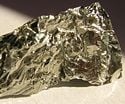Germanium
 From Nwe
From Nwe
|
|||||||||||||||||||||||||||||||||||||||||||||||||
| General | |||||||||||||||||||||||||||||||||||||||||||||||||
|---|---|---|---|---|---|---|---|---|---|---|---|---|---|---|---|---|---|---|---|---|---|---|---|---|---|---|---|---|---|---|---|---|---|---|---|---|---|---|---|---|---|---|---|---|---|---|---|---|---|
| Name, Symbol, Number | germanium, Ge, 32 | ||||||||||||||||||||||||||||||||||||||||||||||||
| Chemical series | metalloids | ||||||||||||||||||||||||||||||||||||||||||||||||
| Group, Period, Block | 14, 4, p | ||||||||||||||||||||||||||||||||||||||||||||||||
| Appearance | grayish white  |
||||||||||||||||||||||||||||||||||||||||||||||||
| Atomic mass | 72.64(1) g/mol | ||||||||||||||||||||||||||||||||||||||||||||||||
| Electron configuration | [Ar] 3d10 4s2 4p2 | ||||||||||||||||||||||||||||||||||||||||||||||||
| Electrons per shell | 2, 8, 18, 4 | ||||||||||||||||||||||||||||||||||||||||||||||||
| Physical properties | |||||||||||||||||||||||||||||||||||||||||||||||||
| Phase | solid | ||||||||||||||||||||||||||||||||||||||||||||||||
| Density (near r.t.) | 5.323 g/cm³ | ||||||||||||||||||||||||||||||||||||||||||||||||
| Liquid density at m.p. | 5.60 g/cm³ | ||||||||||||||||||||||||||||||||||||||||||||||||
| Melting point | 1211.40 K (938.25 °C, 1720.85 °F) |
||||||||||||||||||||||||||||||||||||||||||||||||
| Boiling point | 3106 K (2833 °C, 5131 °F) |
||||||||||||||||||||||||||||||||||||||||||||||||
| Heat of fusion | 36.94 kJ/mol | ||||||||||||||||||||||||||||||||||||||||||||||||
| Heat of vaporization | 334 kJ/mol | ||||||||||||||||||||||||||||||||||||||||||||||||
| Heat capacity | (25 °C) 23.222 J/(mol·K) | ||||||||||||||||||||||||||||||||||||||||||||||||
|
|||||||||||||||||||||||||||||||||||||||||||||||||
| Atomic properties | |||||||||||||||||||||||||||||||||||||||||||||||||
| Crystal structure | Face-centered cubic | ||||||||||||||||||||||||||||||||||||||||||||||||
| Oxidation states | 4 (amphoteric oxide) |
||||||||||||||||||||||||||||||||||||||||||||||||
| Electronegativity | 2.01 (Pauling scale) | ||||||||||||||||||||||||||||||||||||||||||||||||
| Ionization energies (more) |
1st: 762 kJ/mol | ||||||||||||||||||||||||||||||||||||||||||||||||
| 2nd: 1537.5 kJ/mol | |||||||||||||||||||||||||||||||||||||||||||||||||
| 3rd: 3302.1 kJ/mol | |||||||||||||||||||||||||||||||||||||||||||||||||
| Atomic radius | 125 pm | ||||||||||||||||||||||||||||||||||||||||||||||||
| Atomic radius (calc.) | 125 pm | ||||||||||||||||||||||||||||||||||||||||||||||||
| Covalent radius | 122 pm | ||||||||||||||||||||||||||||||||||||||||||||||||
| Miscellaneous | |||||||||||||||||||||||||||||||||||||||||||||||||
| Magnetic ordering | no data | ||||||||||||||||||||||||||||||||||||||||||||||||
| Thermal conductivity | (300 K) 60.2 W/(m·K) | ||||||||||||||||||||||||||||||||||||||||||||||||
| Thermal expansion | (25 °C) 6.0 µm/(m·K) | ||||||||||||||||||||||||||||||||||||||||||||||||
| Speed of sound (thin rod) | (20 °C) 5400 m/s | ||||||||||||||||||||||||||||||||||||||||||||||||
| Mohs hardness | 6.0 | ||||||||||||||||||||||||||||||||||||||||||||||||
| CAS registry number | 7440-56-4 | ||||||||||||||||||||||||||||||||||||||||||||||||
| Notable isotopes | |||||||||||||||||||||||||||||||||||||||||||||||||
|
|||||||||||||||||||||||||||||||||||||||||||||||||
Germanium (chemical symbol Ge, atomic number 32) is a lustrous, hard, grayish-white chemical element. It is classified as a metalloid—that is, its chemical properties are intermediate between those of metals and nonmetals. It is a valuable semiconductor material.
The development of the germanium transistor opened the door to numerous applications in solid-state electronics. Currently, germanium and its compounds are mainly used for fiber-optic communications networks and infrared night vision systems. In addition, germanium is a catalyst for certain polymerization reactions, and single-crystal detectors made with highly purified germanium can be used to identify sources of radiation. Germanium dioxide is useful for wide-angle camera lenses and microscope objective lenses, and silicon germanide is becoming an important semiconductor for high-speed integrated circuits.
Occurrence and extraction
Germanium (Latin Germania, for Germany) is found in argyrodite (sulfide of germanium and silver), coal, germanite, zinc ores, and other minerals.
Germanium is obtained commercially from the smelter dust of zinc ore processing and the combustion byproducts of certain coals. A large reserve of this element is found in coal sources.
This metalloid can be extracted from associated metals by fractional distillation of its volatile tetrachloride. This technique permits the production of ultra-high-purity germanium.
History
Dmitri Mendeleev predicted the existence of germanium (as well as other unidentified elements) in 1871. Thinking of it as a missing member of the silicon group, he called it ekasilicon. When the element was discovered by Clemens Winkler in 1886, it served as an important confirmation of Mendeleev's idea of element periodicity.
| Property | Ekasilicon | Germanium |
| atomic mass | 72 | 72.59 |
| density | 5.5 | 5.35 |
| melting point (°C) | high | 947 |
| color | gray | gray |
The development of the germanium transistor opened the door to countless applications in solid state electronics. From 1950 through the early 1970s, this area provided an increasing market for germanium, but then high-purity silicon began replacing germanium in transistors, diodes, and rectifiers. Silicon has superior electrical properties but requires much higher purity samples—a purity that could not be commercially achieved in the early days. Meanwhile, the demand for germanium increased dramatically for other applications—fiber optics communication networks, infrared night vision systems, and polymerization catalysts.
Notable characteristics
In the periodic table, germanium is located in group 14 (former group 4A), between silicon and tin, and in period 4, between gallium and arsenic. Like silicon and arsenic, it is a metalloid.

In its pure state, germanium is crystalline and brittle, and it retains its luster in air at room temperature. In terms of its atomic arrangement, it has the same crystal structure as diamond.
Germanium is a semiconductor, with electrical properties between those of a metal and an insulator. Unlike most semiconductors, it has a narrow band gap, allowing it to respond efficiently to infrared light. Zone refining techniques have enabled the production of extremely pure, crystalline germanium for semiconductors (with an impurity level of only one part in 1010).
Isotopes
The isotopes of germanium range in atomic mass number from 58 to 89. Of these, there are four stable isotopes: 70Ge, 72Ge, 73Ge, and 74Ge. In addition, 76Ge has been found to have an extremely long half-life, so that for all practical purposes it may be considered stable. The other radioisotopes are very short-lived.
Compounds
- Germane (or germanium tetrahydride, GeH4): It is the simplest germanium hydride and one of the most useful compounds of germanium. It is a gas at ordinary temperatures and pressures. Its molecules have a tetrahedral shape, similar to the molecules of silane (SiH4) and methane (CH4). It is flammable and, when burned in air, produces germanium dioxide (GeO2) and water. The gas decomposes at a temperature of about 600K, yielding germanium and hydrogen. For this reason, the semiconductor industry uses germane as a starting material for growing germanium crystals, using an approach called epitaxy (the growth of a crystal on a crystalline substrate).[1]
- Germanium dioxide (or germanium oxide or germania, GeO2): This compound may come in the form of a white powder or colorless crystals, with a melting point of 1,115 °C. It is a structural analog of silicon dioxide (silica). It forms a “passivation layer” (protective surface film) on pure germanium that is in contact with atmospheric oxygen. The high refractive index and low optical dispersion of this oxide make it useful for wide-angle camera lenses and optical microscope lenses. A mixture of silicon dioxide and germanium dioxide ("silica-germania") is used for optical fibers and optical waveguides. As GeO2 is transparent in the infrared region, it is useful for manufacturing infrared windows and lenses, for night-vision technology in the military and luxury vehicles.[2]
- Germanium tetrachloride (GeCl4): This colorless liquid is used as an intermediate in the production of purified germanium metal. In recent years, it is being used almost exclusively as an intermediate for the production of GeO2, an oxide glass with several unique properties and applications, noted above.
- Organogermanium compounds: These are organic compounds in which germanium atoms are directly bound to carbon atoms.[3]. Examples are tetramethyl germanium and tetraethyl germanium. The chemistry of these compounds lies between that of organosilicon and organotin compounds. Organogermanium compounds are advocated as nontoxic alternatives to many toxic organotin reagents. Compounds such as tetramethyl germanium and tetraethyl germanium are used in the microelectronics industry as precursors for germanium oxide chemical vapor deposition processes.
Applications
- As germanium responds efficiently to infrared light, it is useful for infrared spectroscopes and other optical equipment requiring highly sensitive infrared detectors.
- The index of refraction and dispersion properties of germanium oxide make it useful in wide-angle camera lenses and microscope objective lenses.
- Silicon germanide (or "silicon-germanium," SiGe) is rapidly becoming an important semiconductor material for use in high-speed integrated circuits.
- Germanium may be used as a phosphor in fluorescent lamps.
- It is a catalyst for certain polymerization reactions.
- Single-crystal detectors made with high-purity germanium can precisely identify sources of radiation. These devices can be useful for airport security.
- Some compounds of germanium are useful as chemotherapeutic agents, because they are toxic for certain bacteria but have low toxicity toward mammals.
- Vintage acoustic stompboxes containing germanium transistors have markedly increased in collector value for their distinctive tonal quality.
- In recent years, germanium is being increasingly used in precious metal alloys. For instance, in sterling silver (an alloy of silver with copper or other metals), the presence of germanium has been found to increase tarnish resistance and reduce firescale (a red or purple stain that appears).
Precaution
Germanium has been called an attractive nutritional supplement, able to cure diseases such as cancer and AIDS. As noted above, some germanium compounds are toxic for bacteria but have low toxicity toward mammals. Yet, a 1997 study sponsored by the U.S. Food and Drug Administration concluded that nutritional supplements containing germanium "present potential human health hazard."[4]
See also
- Chemical element
- Metalloid
- Periodic table
Notes
- ↑ Venkatasubramanian, R., R. T. Pickett, and M. L. Timmons. “Epitaxy of germanium using germane in the presence of tetramethylgermanium.” Journal of Applied Physics 66 (1989): 5662-5664. Digital object identifier (DOI): 10.1063/1.343633
- ↑ Hammond, C. R. "The Elements" in David R. Lide (ed.), CRC Handbook of Chemistry and Physics, 85th Edition. Boca Raton, FL: CRC Press, 2004. ISBN 0849304857
- ↑ Yamamoto, Hisashi and Koichiro Oshima (eds.). Main Group Metals in Organic Synthesis. Hoboken, NJ: John Wiley & Sons, 2004. ISBN 3527305084
- ↑ Tao, S. H. and Bolger, P. M. (June 1997). Hazard Assessment of Germanium Supplements. Regulatory Toxicology and Pharmacology 25 (3): 211-219.
References
ISBN links support NWE through referral fees
- Hammond, C. R. "The Elements" in David R. Lide (ed.), CRC Handbook of Chemistry and Physics, 85th ed. Boca Raton, FL: CRC Press, 2004. ISBN 0849304857
- Yamamoto, Hisashi and Koichiro Oshima (eds.). Main Group Metals in Organic Synthesis. Hoboken, NJ: John Wiley & Sons, 2004. ISBN 3527305084
External links
All links retrieved June 20 2017.
- WebElements.com – Germanium
Credits
New World Encyclopedia writers and editors rewrote and completed the Wikipedia article in accordance with New World Encyclopedia standards. This article abides by terms of the Creative Commons CC-by-sa 3.0 License (CC-by-sa), which may be used and disseminated with proper attribution. Credit is due under the terms of this license that can reference both the New World Encyclopedia contributors and the selfless volunteer contributors of the Wikimedia Foundation. To cite this article click here for a list of acceptable citing formats.The history of earlier contributions by wikipedians is accessible to researchers here:
- Germanium history
- Germane history
- Germanium_dioxide history
- Germanium_tetrachloride history
- Organogermanium_compound history
The history of this article since it was imported to New World Encyclopedia:
- History of "Germanium"
Note: Some restrictions may apply to use of individual images which are separately licensed.
↧ Download as ZWI file | Last modified: 02/04/2023 01:31:27 | 45 views
☰ Source: https://www.newworldencyclopedia.org/entry/Germanium | License: CC BY-SA 3.0
 ZWI signed:
ZWI signed:
 KSF
KSF